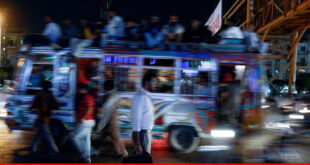Pakistan is among the most densely populated countries of the world. Currently, over 200 million people reside here making it the 6th most populous country of the world. People belonging to various casts, culture and color can be found. The overall literacy rate has always been a huge concern here. Pakistan has one of the lowest literacy rates in the world and according to the United Nations Educational, Scientific and Cultural Organisation (UNESCO), it is 55 percent and Pakistan stands at 160th in total countries of the world.
Many schools and colleges are entering the education industry especially in various big cities of Pakistan but those living in rural areas are on a greater loss.
Even if children want to study, they can’t, due to lack of resources or family pressure. The main reason for families not allowing their children especially girls to study is again illiteracy.
Proper education provides a child with lifelong benefits. It does not just give knowledge, but also makes a better person. It provides with social acceptability in the society and gives empowerment regarding decision making, problem solving and even multi-tasking. Education should not be considered as a want in fact, it should be perceived as a need for every living human being on earth. The general understanding of literacy is to be able to read and write but unfortunately millions of people in Pakistan are deprived of even that.
Pakistan is divided into multiple provinces and each province is facing different literacy scenarios.
Karachi tops the list of the most literate districts in Pakistan, with 78.1 percent of the population of the city having skills to read and write with understanding. There are top 8 best private schools in Karachi Pakistan.
Rawalpindi stood second in the national ranking of literacy rate, according to the latest report prepared by the federal government.
Earlier, Rawalpindi district was used to be the first in terms of the most literate district in 1998, the federal government report on Millennium Development Goals (MDGs) prepared by the Planning Commission disclosed.
There is no change in the ranking for Lahore as it bagged third position in both comparable periods of 1998 and 2005, but its ratio increased in 2005 to the level of 73.3 per cent from 64.7 percent in 1998.
Chakwal district clinched the fourth position with 73.2 percent of its population having become literate in 2005.
Earlier, Jhelum district had assumed the fourth position with 64.1 percent literate people in 1998.
Gujrat district has lost its position in the ranking, which stood at number five in 1998 with 62.5 percent literate people. The position has now gone to Gujranwala, having 69.4 percent literate people in its area in 2005.
In the national ranking during 2005, Jhelum got the sixth position, Gujrat seventh, Quetta eighth, Abbottabad ninth and Sialkot the 10 position.
The ratio of literate people in Sialkot stood at 64.3 percent, which means that abovementioned other districts are ahead of it.
In Punjab, Rawalpindi is on top in the ranking of the most literate districts as its 75.2 percent people are literate. The other four top-ranking districts are Lahore, Chakwal, Gujranwala and Jhelum.
In Sindh, Karachi tops the list of the most literate districts in the province both in 1998 and 2005. There are 78.1 percent literate people in the city. Sukkar comes second with 63.3 percent literate people in 2005 from 46.6 percent in 1998.
Noshahro Feroz district has replaced Hyderabad by securing third position in 2005 with 58.1 percent literate people against Hyderabad’s literacy rate of 44.3 percent in 1998.
Shakirpur stands at fourth position in Sindh’s ranking, as its 55.9 percent people was literate in 2005. Earlier, Noshahro Feroz got the fourth position by securing 39.1 percentages of literate citizens in 1998.
Hyderabad has fallen to the fifth position in 2005 with 52.5 percent literate people, against its third position in 1998 with the literacy ratio of 44.3 percent.
In the Khyber Pakhtunkhwa, Abbottabad tops the list of the most literate districts in 2005 by achieving literacy ratio of 64.7 per cent. Abbottabad was at the top in 1998 too whit 56.6 percent of its people being literate. Haripur district is at number two in 2005 as it was in 1998 with its literacy rate at touched 57.2 percent in 2005 and 53.7 percent in 1998.
The report shows that Malakand, which is generally conceived as volatile, has outpaced Kohat and got third position in the literacy ranking. There were 50.6 percent literate people in Malakand district in 2005 against 44 percent in Kohat in 1998.
In Balochistan, Quetta is at the top of the list with 65.3 percent of its people literate in 2005 against 57.1 percent in 1998.
Despite an increase in the 2015-16 education budget, Pakistan’s current expenditure on education is the lowest in South Asia. Pakistan has a literacy rate of 58 percent, which has improved from 35 percent in 1990-91, but still way behind the Millennium Development Goals (MDG) target of 88 percent, which was to be achieved by the end of 2015.
The report, ‘Public Financing of Education in Pakistan and Agenda for Education Budget 2016-17’, was launched by the Institute of Social and Policy Sciences (I-SAPS). The report also said there are around 24 million out-of-school children in Pakistan, the second highest figure in the world after Nigeria.
“It is heartening to see a visible increase in education budgets for all the provinces in 2015-16, with Balochistan registering an increase of 19 percent, followed by Khyber Pakhtunkhwa with 12 percent, Punjab with 10 percent and Sindh with an increased allocation of 7 percent, compared with the previous year’s budgets.
 PAGE Blog Business Weekly Magazine
PAGE Blog Business Weekly Magazine
